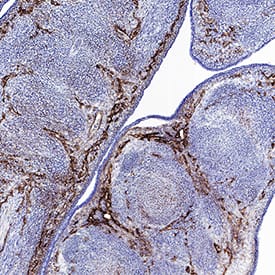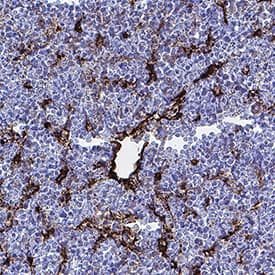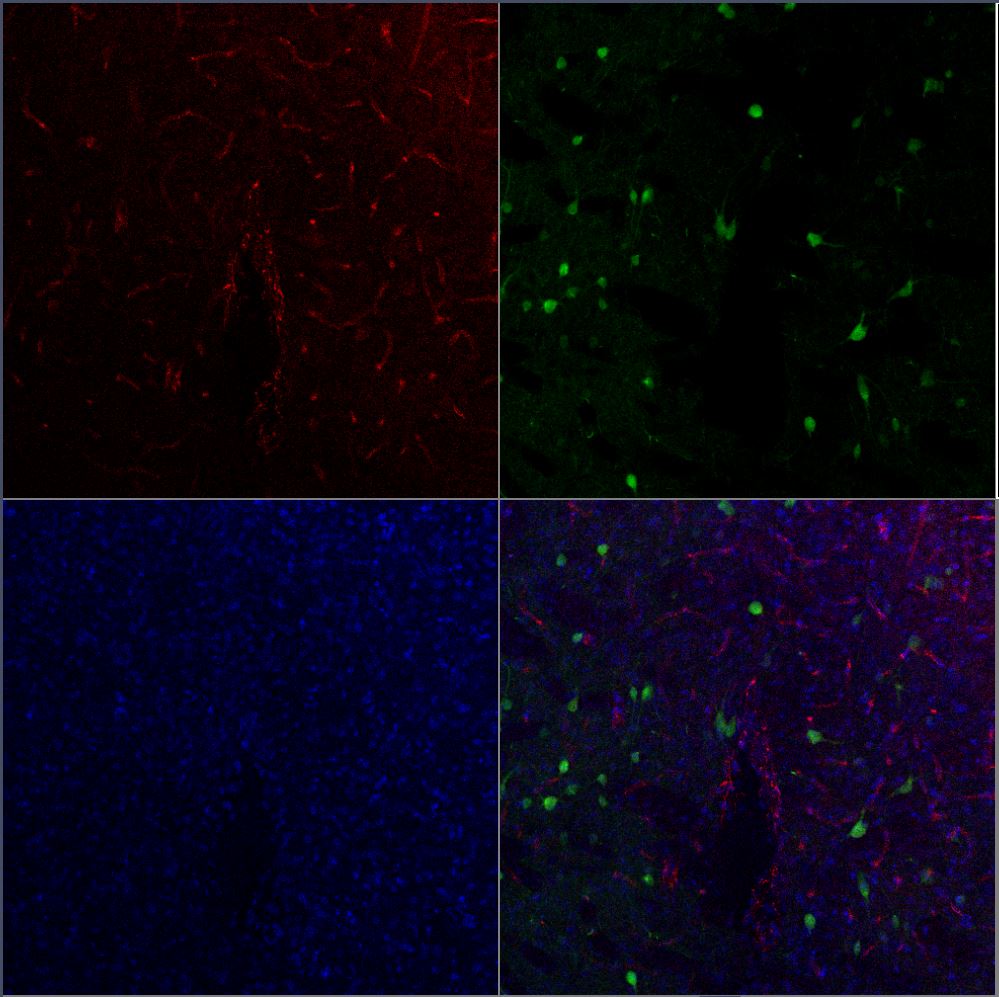Mouse Endoglin/CD105 Antibody Summary
Glu21-Gly581 (predicted)
Accession # NP_031958
*Small pack size (-SP) is supplied either lyophilized or as a 0.2 µm filtered solution in PBS.
Applications
under non-reducing conditions only
Immersion fixed frozen sections of mouse embryo (13.5 d.p.c.)
Please Note: Optimal dilutions should be determined by each laboratory for each application. General Protocols are available in the Technical Information section on our website.
Scientific Data
 View Larger
View Larger
Endoglin/CD105 in Mouse Embryo. Endoglin/CD105 was detected in immersion fixed frozen sections of mouse embryo (13.5 d.p.c.) using Rat Anti-Mouse Endoglin/CD105 Monoclonal Antibody (Catalog # MAB1320) at 10 µg/mL overnight at 4 °C. Tissue was stained using the NorthernLights™ 557-conjugated Anti-Rat IgG Secondary Antibody (red; NL013) and counterstained with DAPI (blue). Specific staining was localized to endothelial cells of the developing hindlimb. View our protocol for Fluorescent IHC Staining of Frozen Tissue Sections.Image depicts staining at 10X magnification.
 View Larger
View Larger
Endoglin/CD105 in Mouse Embryo. Endoglin/CD105 was detected in immersion fixed frozen sections of mouse embryo (13.5 d.p.c.) using Rat Anti-Mouse Endoglin/CD105 Monoclonal Antibody (Catalog # MAB1320) at 10 µg/mL overnight at 4 °C. Tissue was stained using the NorthernLights™ 557-conjugated Anti-Rat IgG Secondary Antibody (red; NL013) and counterstained with DAPI (blue). Specific staining was localized to endothelial cells of the developing hindlimb. View our protocol for Fluorescent IHC Staining of Frozen Tissue Sections.Image depicts staining at 40X magnification.
 View Larger
View Larger
Endoglin/CD105 in Mouse Mesenchymal Stem Cells. Endoglin/CD105 was detected in immersion fixed mouse mesenchymal stem cells using Rat Anti-Mouse Endoglin/CD105 Monoclonal Antibody (Catalog # MAB1320) at 10 µg/mL for 3 hours at room temperature. Cells were stained using the NorthernLights™ 557-conjugated Anti-Rat IgG Secondary Antibody (red; NL013) and counterstained with DAPI (blue). Specific staining was localized to cytoplasmic. View our protocol for Fluorescent ICC Staining of Non-adherent Cells.
 View Larger
View Larger
Detection of Endoglin/CD105 in MS-1 cells by Flow Cytometry MS-1 cells were stained with Rat Anti-Mouse Endoglin/CD105 Monoclonal Antibody (Catalog # MAB1320, filled histogram) or isotype control antibody (Catalog # MAB006, open histogram) followed by Phycoerythrin-conjugated Anti-Rat IgG Secondary Antibody (Catalog # F0105B). View our protocol for Staining Membrane-associated Proteins.
 View Larger
View Larger
Detection of Endoglin/CD105 in Mouse Embryo. Endoglin/CD105 was detected in immersion fixed frozen sections of mouse embryo using Rat Anti-Mouse Endoglin/CD105 Monoclonal Antibody (Catalog # MAB1320) at 3 µg/ml for 1 hour at room temperature followed by incubation with the Anti-Rat IgG VisUCyte™ HRP Polymer Antibody (Catalog # VC005) or the HRP-conjugated Anti-Rat IgG Secondary Antibody (Catalog # HAF005). Tissue was stained using DAB (brown) and counterstained with hematoxylin (blue). Specific staining was localized to endothelial cells of developing limbs. View our protocol for Chromogenic IHC Staining of Frozen Tissue Sections.
 View Larger
View Larger
Detection of Endoglin/CD105 in Mouse Embryo. Endoglin/CD105 was detected in immersion fixed frozen sections of mouse embryo using Rat Anti-Mouse Endoglin/CD105 Monoclonal Antibody (Catalog # MAB1320) at 3 µg/ml for 1 hour at room temperature followed by incubation with the Anti-Rat IgG VisUCyte™ HRP Polymer Antibody (Catalog # VC005) or the HRP-conjugated Anti-Rat IgG Secondary Antibody (Catalog # HAF005). Tissue was stained using DAB (brown) and counterstained with hematoxylin (blue). Specific staining was localized to endothelial cells of the developing liver. View our protocol for Chromogenic IHC Staining of Frozen Tissue Sections.
Preparation and Storage
- 12 months from date of receipt, -20 to -70 °C as supplied.
- 1 month, 2 to 8 °C under sterile conditions after reconstitution.
- 6 months, -20 to -70 °C under sterile conditions after reconstitution.
Background: Endoglin/CD105
Endoglin (CD105) is a 90 kDa type I transmembrane glycoprotein of the zona pellucida (ZP) family of proteins (1-3). Endoglin and betaglycan/T beta RIII are type III receptors for TGF beta superfamily ligands, sharing 71% amino acid (aa) identity within the transmembrane (TM) and cytoplasmic domains. Endoglin is highly expressed on proliferating vascular endothelial cells, chondrocytes, and syncytiotrophoblasts of term placenta, with lower amounts on hematopoietic, mesenchymal, and neural crest stem cells, activated monocytes, and lymphoid and myeloid leukemic cells (2-5). Mouse Endoglin cDNA encodes 653 aa including a 26 aa signal sequence, a 555 aa extracellular domain (ECD) with an orphan domain and a two-part ZP domain, a TM domain, and a 47 aa cytoplasmic domain (1-3). A mouse isoform with a 35 aa cytoplasmic domain (S-endoglin) can oppose effects of long (L) Endoglin (6, 7). The mouse Endoglin ECD shares 69%, 84%, 62%, 63%, and 66% aa identity with human, rat, bovine, porcine, and canine Endoglin, respectively. Endoglin homodimers interact with TGF-beta 1 and TGF-beta 3 (but not TGF-beta 2) but only after binding T beta RII (8). Similarly, they interact with activin-A and BMP-7 via activin type IIA or B receptors, and with BMP-2 via BMPR-1A/ALK-3 or BMPR-1B/ALK-6 (9). BMP-9, however, is reported to bind Endoglin directly (10). Endoglin modifies ligand-induced signaling in multiple ways. For example, expression of Endoglin can inhibit TGF-beta 1 signals but enhance BMP-7 signals in the same myoblast cell line (11). In endothelial cells, Endoglin inhibits T beta RI/ALK5 but enhances ALK1-mediated activation (12). Deletion of mouse Endoglin causes lethal vascular and cardiovascular defects, and human Endoglin haploinsufficiency can a cause the vascular disorder, hereditary hemorrhagic telangiectasia type I (13, 14). These abnormalities confirm the essential function of Endoglin in differentiation of smooth muscle, angiogenesis, and neovascularization (2-4, 12-14). In preeclampsia of pregnancy, high levels of proteolytically generated soluble Endoglin and VEGF R1 (sFlt-1), along with low placental growth factor (PlGF), are pathogenic due to anti-angiogenic activity (15).
- Ge, A.Z. and E.C. Butcher (1994) Gene 138:201.
- ten Dijke, P. et al. (2008) Angiogenesis 11:79.
- Bernabeu, C. et al. (2007) J. Cell. Biochem. 102:1375.
- Mancini, M.L. et al. (2007) Dev. Biol. 308:520.
- Moody, J.L. et al. (2007) Stem Cells 25:2809.
- Velasco, S. et al. (2008) J. Cell Sci. 121:913.
- Perez-Gomez, E. et al. (2005) Oncogene 24:4450.
- Cheifetz, S, et al. (1992) J. Biol. Chem. 267:19027.
- Barbara, N.P. et al. (1999) J. Biol. Chem. 274:584.
- Scharpfenecker, M. et al. (2007) J. Cell Sci. 120:964.
- Scherner, O. et al. (2007) J. Biol. Chem. 282:13934.
- Pece-Barbara, N. et al. (2005) J. Biol. Chem. 280:27800.
- Arthur, H.M. et al. (2000) Dev. Biol. 217:42.
- Lebrin, F. and C.L. Mummery (2008) Trends Cardiovasc. Med. 18:25.
- Venkatesha, S. et al. (2006) Nat. Med. 12:642.
Product Datasheets
Citations for Mouse Endoglin/CD105 Antibody
R&D Systems personnel manually curate a database that contains references using R&D Systems products. The data collected includes not only links to publications in PubMed, but also provides information about sample types, species, and experimental conditions.
14
Citations: Showing 1 - 10
Filter your results:
Filter by:
-
Multilayered, Hyaluronic Acid-Based Hydrogel Formulations Suitable for Automated 3D High Throughput Drug Screening of Cancer-Stromal Cell Cocultures.
Authors: Engel BJ, Constantinou PE, Sablatura LK et al.
Adv Healthc Mater
-
Release of STK24/25 suppression on MEKK3 signaling in endothelial cells confers Cerebral cavernous malformation
Authors: X Yang, ST Wu, R Gao, R Wang, Y Wang, Z Dong, L Wang, C Qi, X Wang, ML Schmitz, R Liu, Z Han, L Wang, X Zheng
JCI Insight, 2023-03-08;0(0):.
Species: Mouse
Sample Types: Embryo
Applications: IHC -
Assessment of the association of OCT3/4 with GLUT1 and CD105 in oral squamous cell carcinoma using dual immunohistochemistry
Authors: Samira Derakhshan, Nazanin Mahdavi, Neda Kardouni Khoozestani, Bita Nasr Esfahani, Foroozan Heidarian, Sedigheh Rahrotaban et al.
BMC Oral Health
-
Immature Vascular Smooth Muscle Cells in Healthy Murine Arteries and Atherosclerotic Plaques: Localization and Activity
Authors: A Balatskiy, I Ozhimalov, M Balatskaya, A Savina, J Filatova, N Kalinina, V Popov, V Tkachuk
International Journal of Molecular Sciences, 2022-02-03;23(3):.
Species: Mouse, Transgenic Mouse
Sample Types: Whole Tissue
Applications: IHC -
Gli1+ Cells Couple with Type H Vessels and Are Required for Type H Vessel Formation
Authors: J Chen, M Li, AQ Liu, CX Zheng, LH Bao, K Chen, XL Xu, JT Guan, M Bai, T Zhou, BD Sui, DH Li, Y Jin, CH Hu
Stem Cell Reports, 2020-07-14;15(1):110-124.
Species: Mouse
Sample Types: Whole Tissue
Applications: IHC -
Caspase-8 modulates physiological and pathological angiogenesis during retina development
Authors: Nathalie Tisch, Aida Freire-Valls, Rosario Yerbes, Isidora Paredes, Silvia La Porta, Xiaohong Wang et al.
Journal of Clinical Investigation
-
Volume expansion and TRPV4 activation regulate stem cell fate in three-dimensional microenvironments
Authors: HP Lee, R Stowers, O Chaudhuri
Nat Commun, 2019-01-31;10(1):529.
Species: Mouse
Sample Types: Hydrogel Cells
Applications: IHC-Fr -
Gli1(+) Mesenchymal Stromal Cells Are a Key Driver of Bone Marrow Fibrosis and an Important Cellular Therapeutic Target
Authors: RK Schneider, A Mullally, A Dugourd, F Peisker, R Hoogenboez, PMH Van Strien, EM Bindels, D Heckl, G Büsche, D Fleck, G Müller-New, J Wongboonsi, M Ventura Fe, VG Puelles, J Saez-Rodri, BL Ebert, BD Humphreys, R Kramann
Cell Stem Cell, 2017-04-27;0(0):.
Species: Human
Sample Types: Whole Tissue
Applications: IHC -
Bistable Epigenetic States Explain Age-Dependent Decline in Mesenchymal Stem Cell Heterogeneity
Authors: Z Hamidouche, K Rother, J Przybilla, A Krinner, D Clay, L Hopp, C Fabian, A Stolzing, H Binder, P Charbord, J Galle
Stem Cells, 2016-11-08;35(3):694-704.
Species: Mouse
Sample Types: Whole Cells
Applications: Flow Cytometry -
Hiding inside? Intracellular expression of non-glycosylated c-kit protein in cardiac progenitor cells
Authors: Huilin Shi, Christopher A. Drummond, Xiaoming Fan, Steven T. Haller, Jiang Liu, Deepak Malhotra et al.
Stem Cell Research
-
Retinal angiogenesis in the Ins2(Akita) mouse model of diabetic retinopathy
Authors: Zongchao Han, Junjing Guo, Shannon M. Conley, Muna I. Naash
Investigative Opthalmology & Visual Science
-
Mesenchymal stem cells originating from ES cells show high telomerase activity and therapeutic benefits.
Authors: Ninagawa N, Murakami R, Isobe E, Tanaka Y, Nakagawa H, Torihashi S
Differentiation, 2011-08-19;82(3):153-64.
Species: Mouse
Sample Types: Whole Cells
Applications: Cell Selection, ICC -
PIR-B-deficient mice are susceptible to Salmonella infection.
Authors: Torii I, Oka S, Hotomi M, Benjamin WH, Takai T, Kearney JF, Briles DE, Kubagawa H
J. Immunol., 2008-09-15;181(6):4229-39.
Species: Mouse
Sample Types: Whole Cells
Applications: ICC -
sFRP2 Supersedes VEGF as an Age-related Driver of Angiogenesis in Melanoma, Affecting Response to Anti-VEGF Therapy in Older Patients.
Authors: Fane, M E, Ecker, B L Et al.
Clin Cancer Res
FAQs
No product specific FAQs exist for this product, however you may
View all Antibody FAQsReviews for Mouse Endoglin/CD105 Antibody
Average Rating: 4.5 (Based on 2 Reviews)
Have you used Mouse Endoglin/CD105 Antibody?
Submit a review and receive an Amazon gift card.
$25/€18/£15/$25CAN/¥75 Yuan/¥2500 Yen for a review with an image
$10/€7/£6/$10 CAD/¥70 Yuan/¥1110 Yen for a review without an image
Filter by:





